2017 NISSAN LEAF warning
[x] Cancel search: warningPage 129 of 424
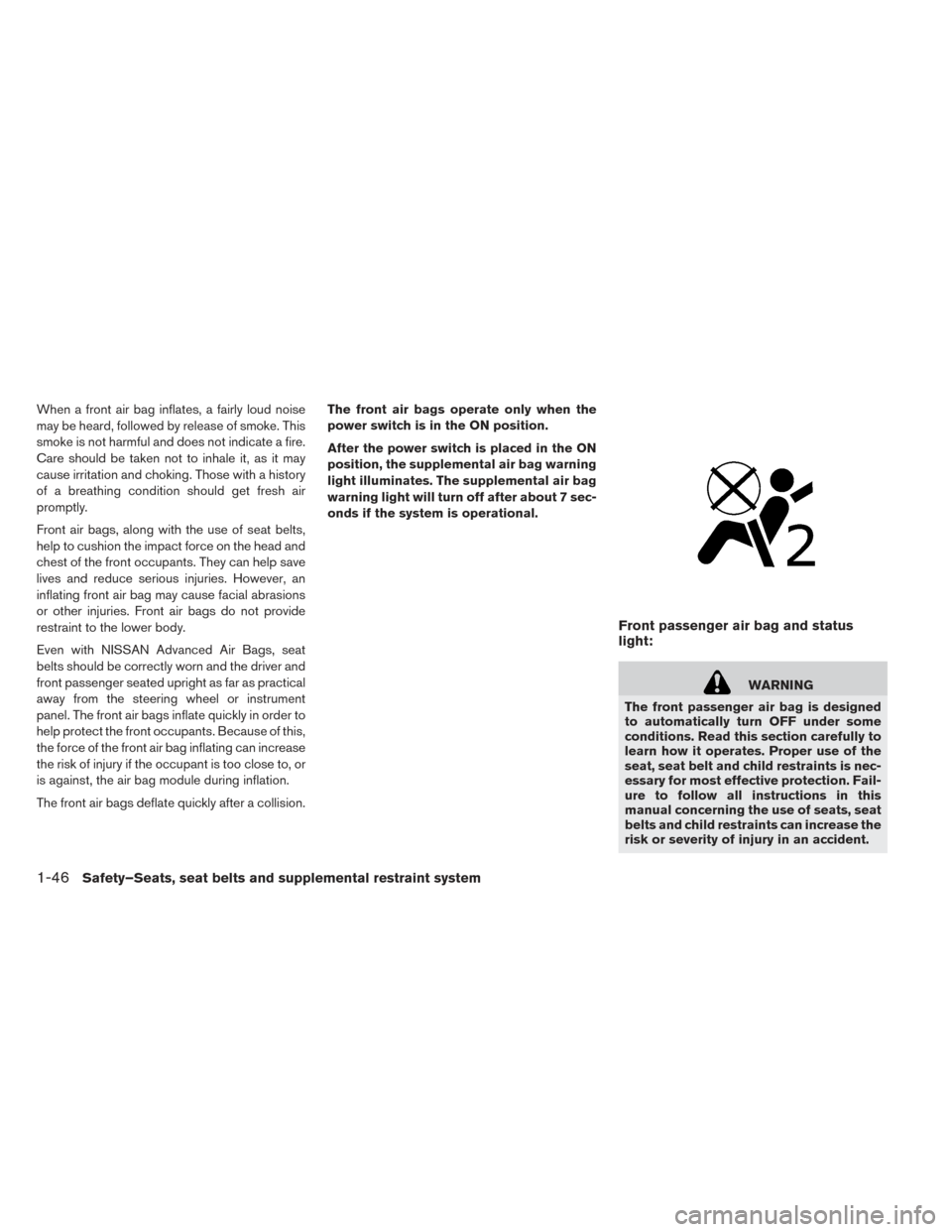
When a front air bag inflates, a fairly loud noise
may be heard, followed by release of smoke. This
smoke is not harmful and does not indicate a fire.
Care should be taken not to inhale it, as it may
cause irritation and choking. Those with a history
of a breathing condition should get fresh air
promptly.
Front air bags, along with the use of seat belts,
help to cushion the impact force on the head and
chest of the front occupants. They can help save
lives and reduce serious injuries. However, an
inflating front air bag may cause facial abrasions
or other injuries. Front air bags do not provide
restraint to the lower body.
Even with NISSAN Advanced Air Bags, seat
belts should be correctly worn and the driver and
front passenger seated upright as far as practical
away from the steering wheel or instrument
panel. The front air bags inflate quickly in order to
help protect the front occupants. Because of this,
the force of the front air bag inflating can increase
the risk of injury if the occupant is too close to, or
is against, the air bag module during inflation.
The front air bags deflate quickly after a collision.The front air bags operate only when the
power switch is in the ON position.
After the power switch is placed in the ON
position, the supplemental air bag warning
light illuminates. The supplemental air bag
warning light will turn off after about 7 sec-
onds if the system is operational.
Front passenger air bag and status
light:
WARNING
The front passenger air bag is designed
to automatically turn OFF under some
conditions. Read this section carefully to
learn how it operates. Proper use of the
seat, seat belt and child restraints is nec-
essary for most effective protection. Fail-
ure to follow all instructions in this
manual concerning the use of seats, seat
belts and child restraints can increase the
risk or severity of injury in an accident.
1-46Safety–Seats, seat belts and supplemental restraint system
Page 132 of 424
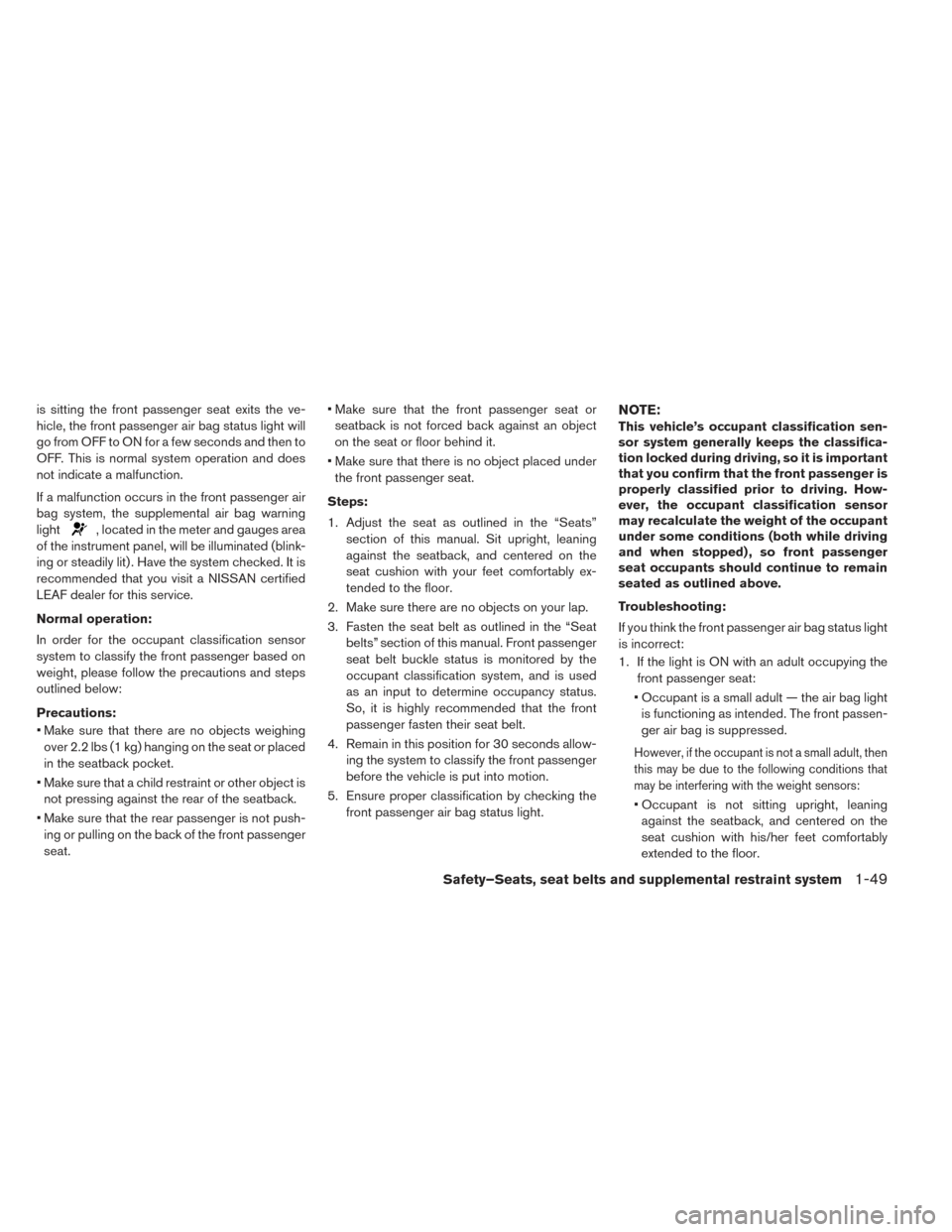
is sitting the front passenger seat exits the ve-
hicle, the front passenger air bag status light will
go from OFF to ON for a few seconds and then to
OFF. This is normal system operation and does
not indicate a malfunction.
If a malfunction occurs in the front passenger air
bag system, the supplemental air bag warning
light
, located in the meter and gauges area
of the instrument panel, will be illuminated (blink-
ing or steadily lit) . Have the system checked. It is
recommended that you visit a NISSAN certified
LEAF dealer for this service.
Normal operation:
In order for the occupant classification sensor
system to classify the front passenger based on
weight, please follow the precautions and steps
outlined below:
Precautions:
• Make sure that there are no objects weighing over 2.2 lbs (1 kg) hanging on the seat or placed
in the seatback pocket.
• Make sure that a child restraint or other object is not pressing against the rear of the seatback.
• Make sure that the rear passenger is not push- ing or pulling on the back of the front passenger
seat. • Make sure that the front passenger seat or
seatback is not forced back against an object
on the seat or floor behind it.
• Make sure that there is no object placed under the front passenger seat.
Steps:
1. Adjust the seat as outlined in the “Seats” section of this manual. Sit upright, leaning
against the seatback, and centered on the
seat cushion with your feet comfortably ex-
tended to the floor.
2. Make sure there are no objects on your lap.
3. Fasten the seat belt as outlined in the “Seat belts” section of this manual. Front passenger
seat belt buckle status is monitored by the
occupant classification system, and is used
as an input to determine occupancy status.
So, it is highly recommended that the front
passenger fasten their seat belt.
4. Remain in this position for 30 seconds allow- ing the system to classify the front passenger
before the vehicle is put into motion.
5. Ensure proper classification by checking the front passenger air bag status light.
NOTE:
This vehicle’s occupant classification sen-
sor system generally keeps the classifica-
tion locked during driving, so it is important
that you confirm that the front passenger is
properly classified prior to driving. How-
ever, the occupant classification sensor
may recalculate the weight of the occupant
under some conditions (both while driving
and when stopped) , so front passenger
seat occupants should continue to remain
seated as outlined above.
Troubleshooting:
If you think the front passenger air bag status light
is incorrect:
1. If the light is ON with an adult occupying thefront passenger seat:
• Occupant is a small adult — the air bag light is functioning as intended. The front passen-
ger air bag is suppressed.
However, if the occupant is not a small adult, then
this may be due to the following conditions that
may be interfering with the weight sensors:
• Occupant is not sitting upright, leaningagainst the seatback, and centered on the
seat cushion with his/her feet comfortably
extended to the floor.
Safety–Seats, seat belts and supplemental restraint system1-49
Page 134 of 424
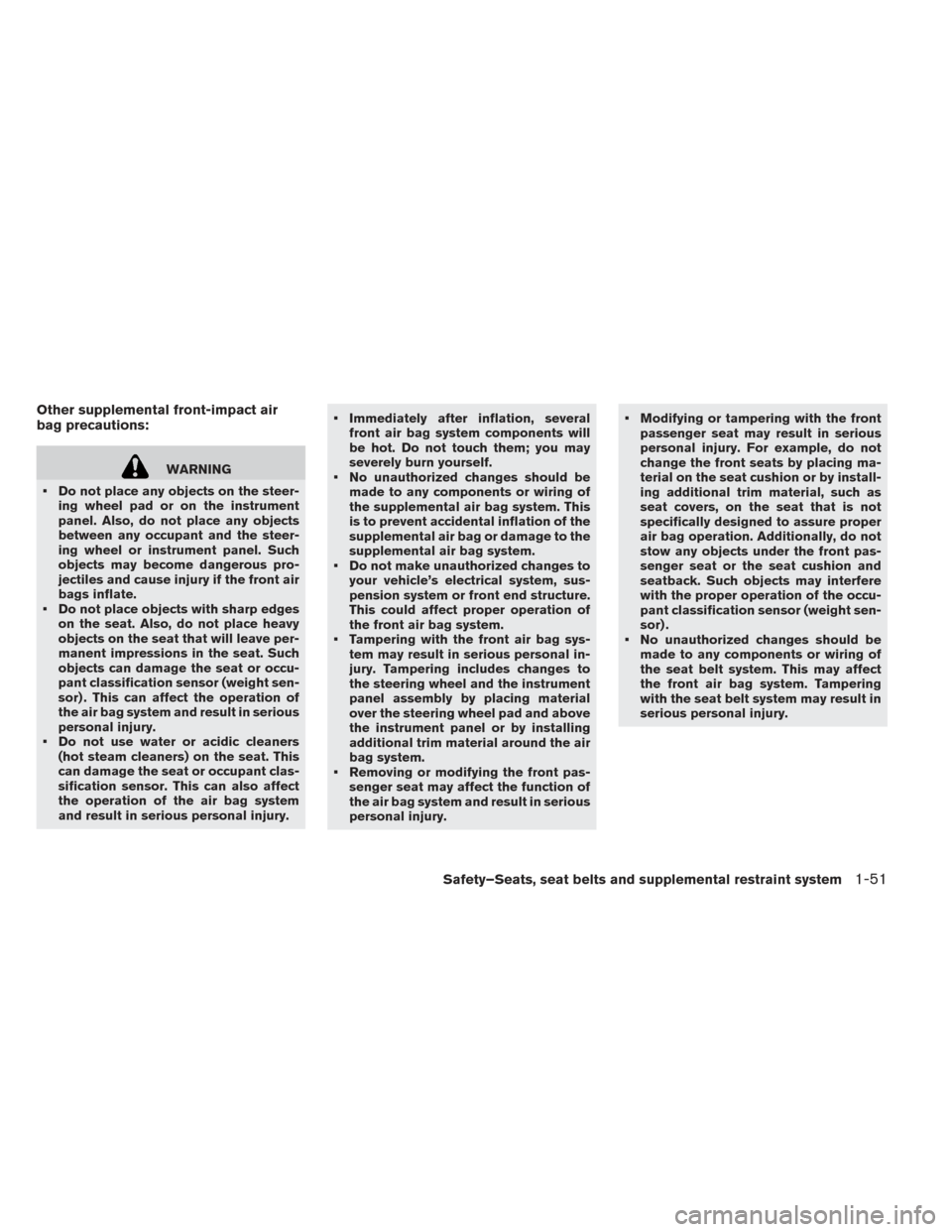
Other supplemental front-impact air
bag precautions:
WARNING
• Do not place any objects on the steer- ing wheel pad or on the instrument
panel. Also, do not place any objects
between any occupant and the steer-
ing wheel or instrument panel. Such
objects may become dangerous pro-
jectiles and cause injury if the front air
bags inflate.
• Do not place objects with sharp edges on the seat. Also, do not place heavy
objects on the seat that will leave per-
manent impressions in the seat. Such
objects can damage the seat or occu-
pant classification sensor (weight sen-
sor) . This can affect the operation of
the air bag system and result in serious
personal injury.
• Do not use water or acidic cleaners (hot steam cleaners) on the seat. This
can damage the seat or occupant clas-
sification sensor. This can also affect
the operation of the air bag system
and result in serious personal injury. • Immediately after inflation, several
front air bag system components will
be hot. Do not touch them; you may
severely burn yourself.
• No unauthorized changes should be made to any components or wiring of
the supplemental air bag system. This
is to prevent accidental inflation of the
supplemental air bag or damage to the
supplemental air bag system.
• Do not make unauthorized changes to your vehicle’s electrical system, sus-
pension system or front end structure.
This could affect proper operation of
the front air bag system.
• Tampering with the front air bag sys- tem may result in serious personal in-
jury. Tampering includes changes to
the steering wheel and the instrument
panel assembly by placing material
over the steering wheel pad and above
the instrument panel or by installing
additional trim material around the air
bag system.
• Removing or modifying the front pas- senger seat may affect the function of
the air bag system and result in serious
personal injury. • Modifying or tampering with the front
passenger seat may result in serious
personal injury. For example, do not
change the front seats by placing ma-
terial on the seat cushion or by install-
ing additional trim material, such as
seat covers, on the seat that is not
specifically designed to assure proper
air bag operation. Additionally, do not
stow any objects under the front pas-
senger seat or the seat cushion and
seatback. Such objects may interfere
with the proper operation of the occu-
pant classification sensor (weight sen-
sor) .
• No unauthorized changes should be made to any components or wiring of
the seat belt system. This may affect
the front air bag system. Tampering
with the seat belt system may result in
serious personal injury.
Safety–Seats, seat belts and supplemental restraint system1-51
Page 135 of 424
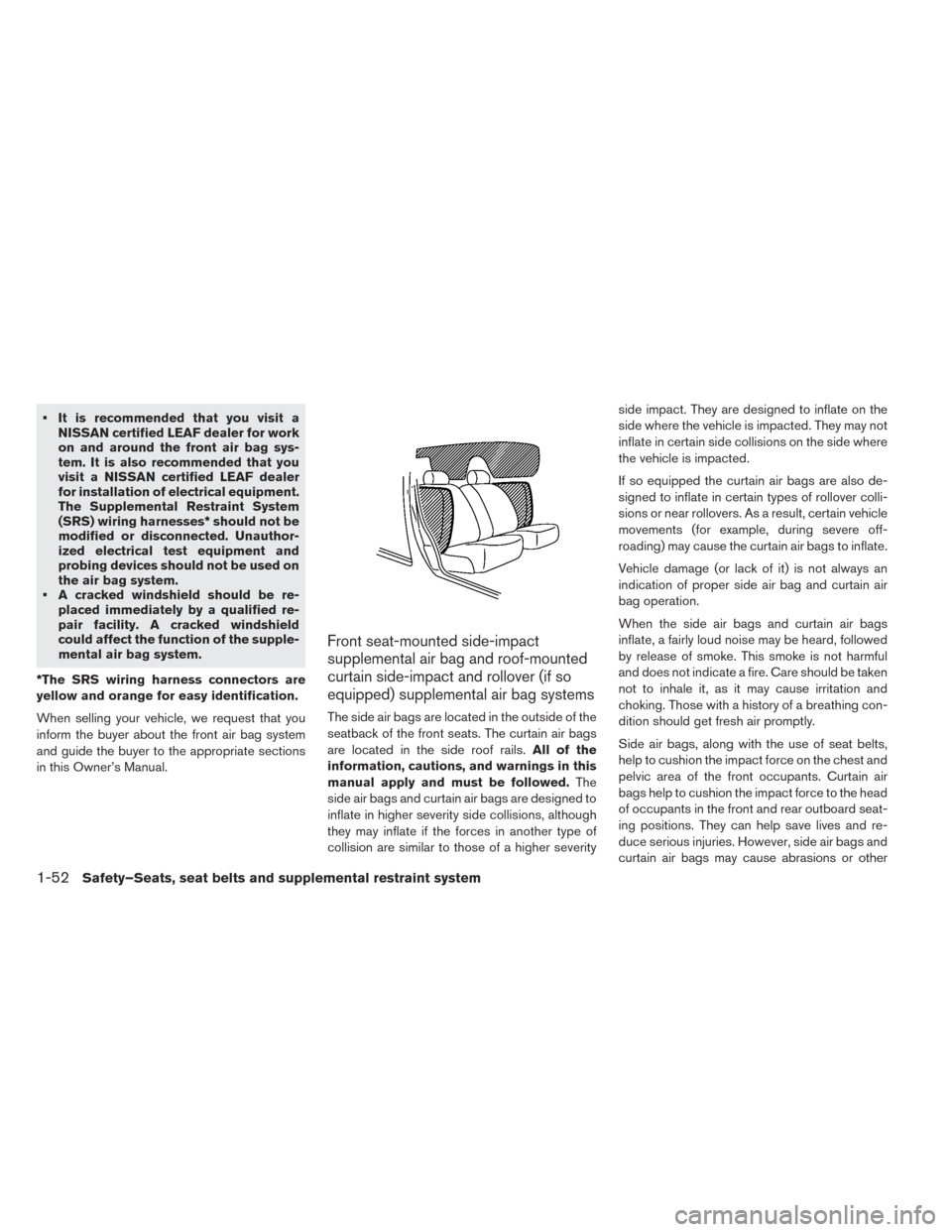
• It is recommended that you visit aNISSAN certified LEAF dealer for work
on and around the front air bag sys-
tem. It is also recommended that you
visit a NISSAN certified LEAF dealer
for installation of electrical equipment.
The Supplemental Restraint System
(SRS) wiring harnesses* should not be
modified or disconnected. Unauthor-
ized electrical test equipment and
probing devices should not be used on
the air bag system.
• A cracked windshield should be re- placed immediately by a qualified re-
pair facility. A cracked windshield
could affect the function of the supple-
mental air bag system.
*The SRS wiring harness connectors are
yellow and orange for easy identification.
When selling your vehicle, we request that you
inform the buyer about the front air bag system
and guide the buyer to the appropriate sections
in this Owner’s Manual.
Front seat-mounted side-impact
supplemental air bag and roof-mounted
curtain side-impact and rollover (if so
equipped) supplemental air bag systems
The side air bags are located in the outside of the
seatback of the front seats. The curtain air bags
are located in the side roof rails. All of the
information, cautions, and warnings in this
manual apply and must be followed. The
side air bags and curtain air bags are designed to
inflate in higher severity side collisions, although
they may inflate if the forces in another type of
collision are similar to those of a higher severity side impact. They are designed to inflate on the
side where the vehicle is impacted. They may not
inflate in certain side collisions on the side where
the vehicle is impacted.
If so equipped the curtain air bags are also de-
signed to inflate in certain types of rollover colli-
sions or near rollovers. As a result, certain vehicle
movements (for example, during severe off-
roading) may cause the curtain air bags to inflate.
Vehicle damage (or lack of it) is not always an
indication of proper side air bag and curtain air
bag operation.
When the side air bags and curtain air bags
inflate, a fairly loud noise may be heard, followed
by release of smoke. This smoke is not harmful
and does not indicate a fire. Care should be taken
not to inhale it, as it may cause irritation and
choking. Those with a history of a breathing con-
dition should get fresh air promptly.
Side air bags, along with the use of seat belts,
help to cushion the impact force on the chest and
pelvic area of the front occupants. Curtain air
bags help to cushion the impact force to the head
of occupants in the front and rear outboard seat-
ing positions. They can help save lives and re-
duce serious injuries. However, side air bags and
curtain air bags may cause abrasions or other
1-52Safety–Seats, seat belts and supplemental restraint system
Page 136 of 424
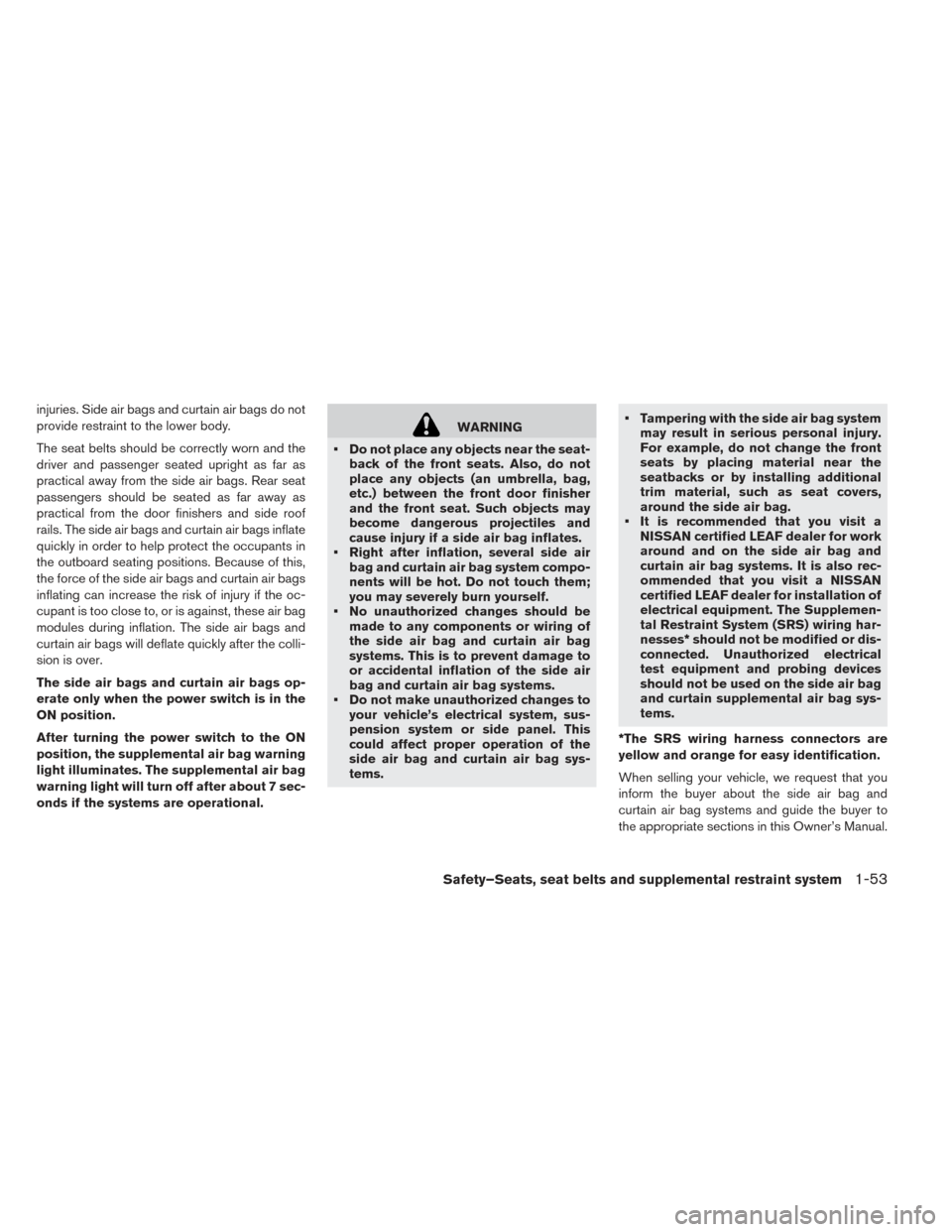
injuries. Side air bags and curtain air bags do not
provide restraint to the lower body.
The seat belts should be correctly worn and the
driver and passenger seated upright as far as
practical away from the side air bags. Rear seat
passengers should be seated as far away as
practical from the door finishers and side roof
rails. The side air bags and curtain air bags inflate
quickly in order to help protect the occupants in
the outboard seating positions. Because of this,
the force of the side air bags and curtain air bags
inflating can increase the risk of injury if the oc-
cupant is too close to, or is against, these air bag
modules during inflation. The side air bags and
curtain air bags will deflate quickly after the colli-
sion is over.
The side air bags and curtain air bags op-
erate only when the power switch is in the
ON position.
After turning the power switch to the ON
position, the supplemental air bag warning
light illuminates. The supplemental air bag
warning light will turn off after about 7 sec-
onds if the systems are operational.
WARNING
• Do not place any objects near the seat- back of the front seats. Also, do not
place any objects (an umbrella, bag,
etc.) between the front door finisher
and the front seat. Such objects may
become dangerous projectiles and
cause injury if a side air bag inflates.
• Right after inflation, several side air bag and curtain air bag system compo-
nents will be hot. Do not touch them;
you may severely burn yourself.
• No unauthorized changes should be made to any components or wiring of
the side air bag and curtain air bag
systems. This is to prevent damage to
or accidental inflation of the side air
bag and curtain air bag systems.
• Do not make unauthorized changes to your vehicle’s electrical system, sus-
pension system or side panel. This
could affect proper operation of the
side air bag and curtain air bag sys-
tems. • Tampering with the side air bag system
may result in serious personal injury.
For example, do not change the front
seats by placing material near the
seatbacks or by installing additional
trim material, such as seat covers,
around the side air bag.
• It is recommended that you visit a NISSAN certified LEAF dealer for work
around and on the side air bag and
curtain air bag systems. It is also rec-
ommended that you visit a NISSAN
certified LEAF dealer for installation of
electrical equipment. The Supplemen-
tal Restraint System (SRS) wiring har-
nesses* should not be modified or dis-
connected. Unauthorized electrical
test equipment and probing devices
should not be used on the side air bag
and curtain supplemental air bag sys-
tems.
*The SRS wiring harness connectors are
yellow and orange for easy identification.
When selling your vehicle, we request that you
inform the buyer about the side air bag and
curtain air bag systems and guide the buyer to
the appropriate sections in this Owner’s Manual.
Safety–Seats, seat belts and supplemental restraint system1-53
Page 137 of 424
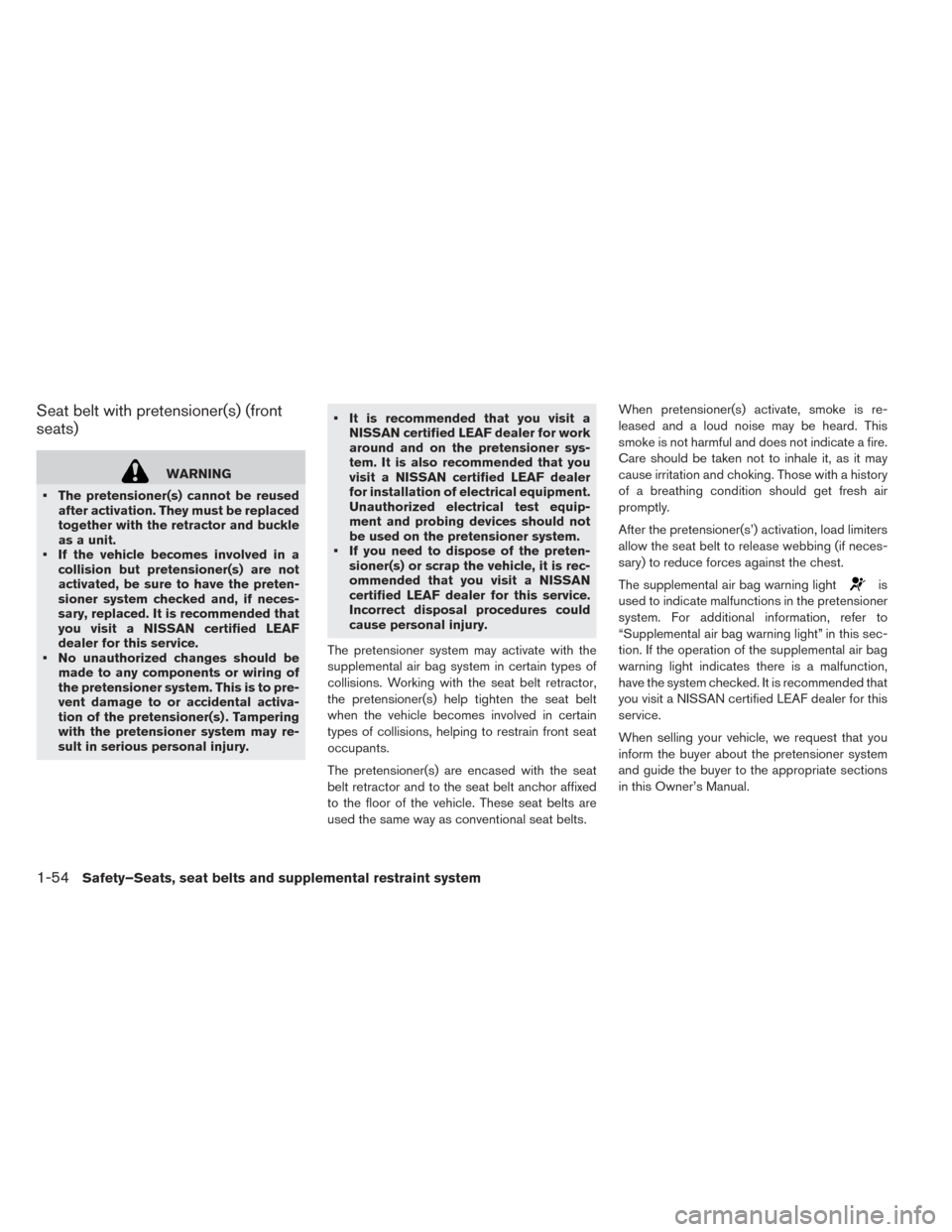
Seat belt with pretensioner(s) (front
seats)
WARNING
• The pretensioner(s) cannot be reused after activation. They must be replaced
together with the retractor and buckle
as a unit.
• If the vehicle becomes involved in a collision but pretensioner(s) are not
activated, be sure to have the preten-
sioner system checked and, if neces-
sary, replaced. It is recommended that
you visit a NISSAN certified LEAF
dealer for this service.
• No unauthorized changes should be made to any components or wiring of
the pretensioner system. This is to pre-
vent damage to or accidental activa-
tion of the pretensioner(s) . Tampering
with the pretensioner system may re-
sult in serious personal injury. • It is recommended that you visit a
NISSAN certified LEAF dealer for work
around and on the pretensioner sys-
tem. It is also recommended that you
visit a NISSAN certified LEAF dealer
for installation of electrical equipment.
Unauthorized electrical test equip-
ment and probing devices should not
be used on the pretensioner system.
• If you need to dispose of the preten- sioner(s) or scrap the vehicle, it is rec-
ommended that you visit a NISSAN
certified LEAF dealer for this service.
Incorrect disposal procedures could
cause personal injury.
The pretensioner system may activate with the
supplemental air bag system in certain types of
collisions. Working with the seat belt retractor,
the pretensioner(s) help tighten the seat belt
when the vehicle becomes involved in certain
types of collisions, helping to restrain front seat
occupants.
The pretensioner(s) are encased with the seat
belt retractor and to the seat belt anchor affixed
to the floor of the vehicle. These seat belts are
used the same way as conventional seat belts. When pretensioner(s) activate, smoke is re-
leased and a loud noise may be heard. This
smoke is not harmful and does not indicate a fire.
Care should be taken not to inhale it, as it may
cause irritation and choking. Those with a history
of a breathing condition should get fresh air
promptly.
After the pretensioner(s’) activation, load limiters
allow the seat belt to release webbing (if neces-
sary) to reduce forces against the chest.
The supplemental air bag warning light
is
used to indicate malfunctions in the pretensioner
system. For additional information, refer to
“Supplemental air bag warning light” in this sec-
tion. If the operation of the supplemental air bag
warning light indicates there is a malfunction,
have the system checked. It is recommended that
you visit a NISSAN certified LEAF dealer for this
service.
When selling your vehicle, we request that you
inform the buyer about the pretensioner system
and guide the buyer to the appropriate sections
in this Owner’s Manual.
1-54Safety–Seats, seat belts and supplemental restraint system
Page 138 of 424
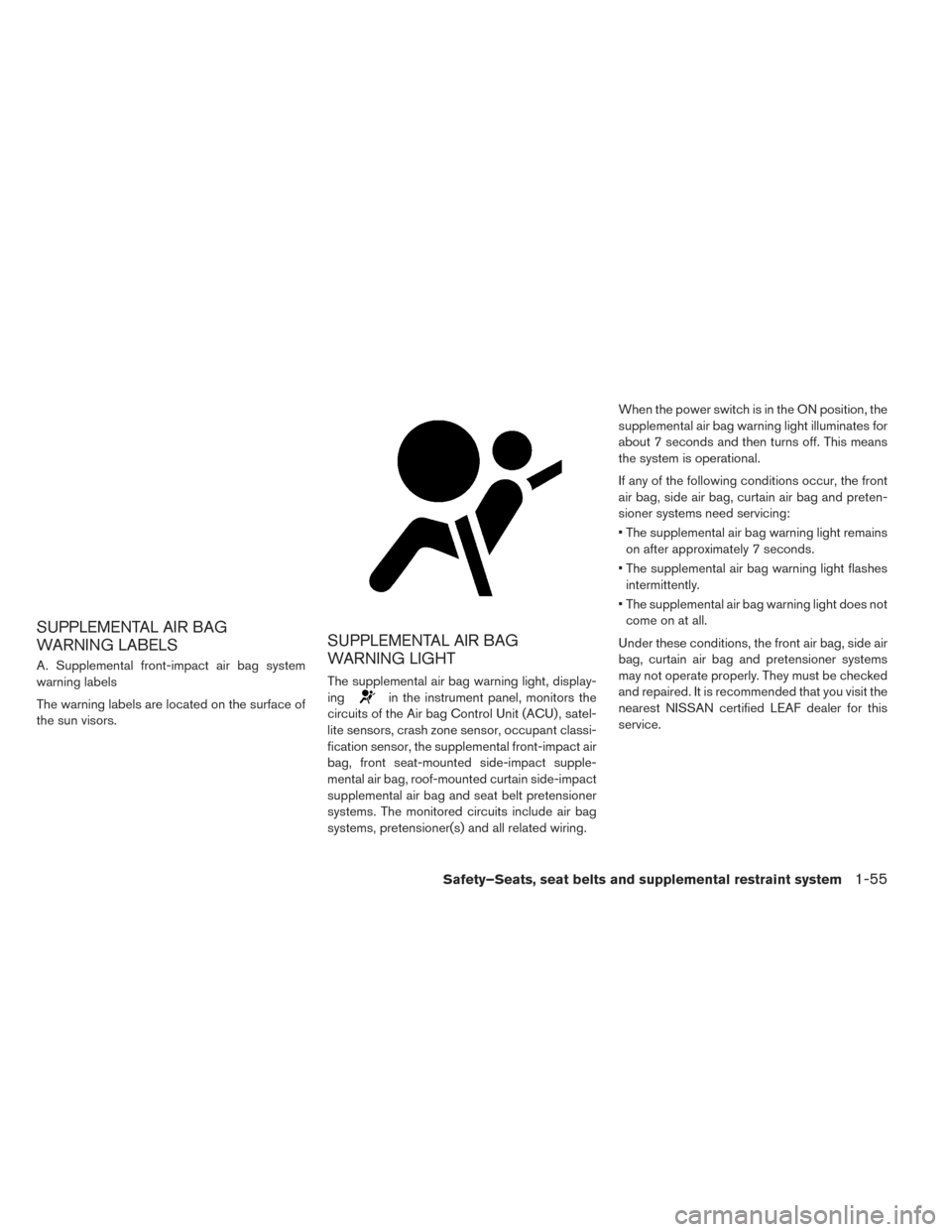
SUPPLEMENTAL AIR BAG
WARNING LABELS
A. Supplemental front-impact air bag system
warning labels
The warning labels are located on the surface of
the sun visors.
SUPPLEMENTAL AIR BAG
WARNING LIGHT
The supplemental air bag warning light, display-
ing
in the instrument panel, monitors the
circuits of the Air bag Control Unit (ACU) , satel-
lite sensors, crash zone sensor, occupant classi-
fication sensor, the supplemental front-impact air
bag, front seat-mounted side-impact supple-
mental air bag, roof-mounted curtain side-impact
supplemental air bag and seat belt pretensioner
systems. The monitored circuits include air bag
systems, pretensioner(s) and all related wiring. When the power switch is in the ON position, the
supplemental air bag warning light illuminates for
about 7 seconds and then turns off. This means
the system is operational.
If any of the following conditions occur, the front
air bag, side air bag, curtain air bag and preten-
sioner systems need servicing:
• The supplemental air bag warning light remains
on after approximately 7 seconds.
• The supplemental air bag warning light flashes intermittently.
• The supplemental air bag warning light does not come on at all.
Under these conditions, the front air bag, side air
bag, curtain air bag and pretensioner systems
may not operate properly. They must be checked
and repaired. It is recommended that you visit the
nearest NISSAN certified LEAF dealer for this
service.
Safety–Seats, seat belts and supplemental restraint system1-55
Page 139 of 424
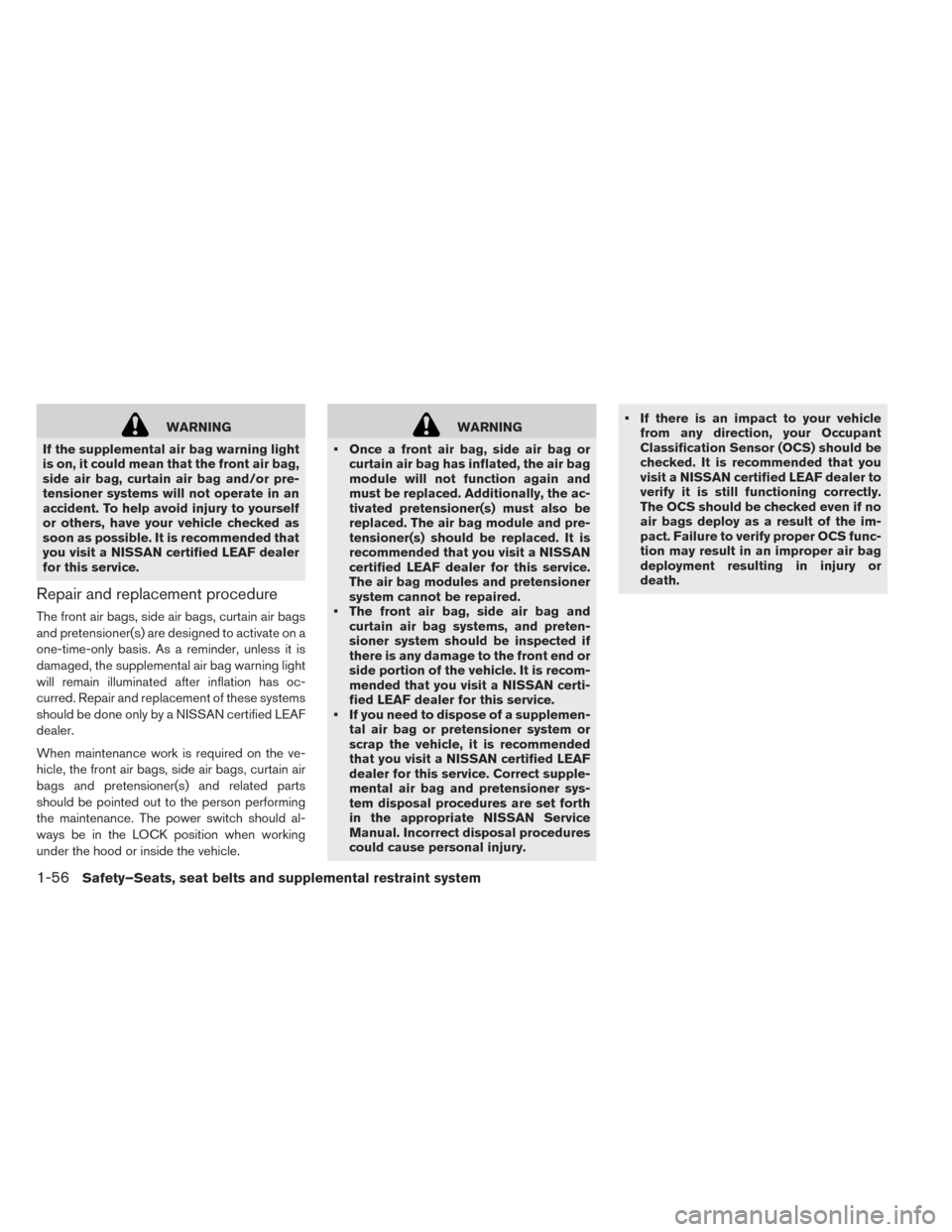
WARNING
If the supplemental air bag warning light
is on, it could mean that the front air bag,
side air bag, curtain air bag and/or pre-
tensioner systems will not operate in an
accident. To help avoid injury to yourself
or others, have your vehicle checked as
soon as possible. It is recommended that
you visit a NISSAN certified LEAF dealer
for this service.
Repair and replacement procedure
The front air bags, side air bags, curtain air bags
and pretensioner(s) are designed to activate on a
one-time-only basis. As a reminder, unless it is
damaged, the supplemental air bag warning light
will remain illuminated after inflation has oc-
curred. Repair and replacement of these systems
should be done only by a NISSAN certified LEAF
dealer.
When maintenance work is required on the ve-
hicle, the front air bags, side air bags, curtain air
bags and pretensioner(s) and related parts
should be pointed out to the person performing
the maintenance. The power switch should al-
ways be in the LOCK position when working
under the hood or inside the vehicle.
WARNING
• Once a front air bag, side air bag or curtain air bag has inflated, the air bag
module will not function again and
must be replaced. Additionally, the ac-
tivated pretensioner(s) must also be
replaced. The air bag module and pre-
tensioner(s) should be replaced. It is
recommended that you visit a NISSAN
certified LEAF dealer for this service.
The air bag modules and pretensioner
system cannot be repaired.
• The front air bag, side air bag and curtain air bag systems, and preten-
sioner system should be inspected if
there is any damage to the front end or
side portion of the vehicle. It is recom-
mended that you visit a NISSAN certi-
fied LEAF dealer for this service.
• If you need to dispose of a supplemen- tal air bag or pretensioner system or
scrap the vehicle, it is recommended
that you visit a NISSAN certified LEAF
dealer for this service. Correct supple-
mental air bag and pretensioner sys-
tem disposal procedures are set forth
in the appropriate NISSAN Service
Manual. Incorrect disposal procedures
could cause personal injury. • If there is an impact to your vehicle
from any direction, your Occupant
Classification Sensor (OCS) should be
checked. It is recommended that you
visit a NISSAN certified LEAF dealer to
verify it is still functioning correctly.
The OCS should be checked even if no
air bags deploy as a result of the im-
pact. Failure to verify proper OCS func-
tion may result in an improper air bag
deployment resulting in injury or
death.
1-56Safety–Seats, seat belts and supplemental restraint system